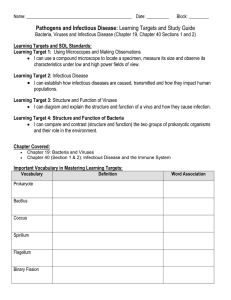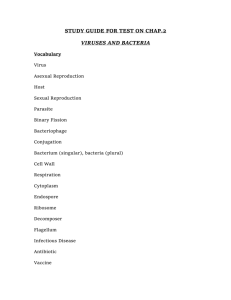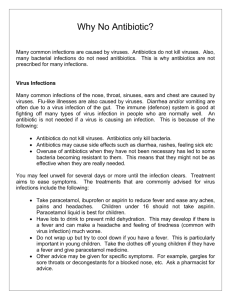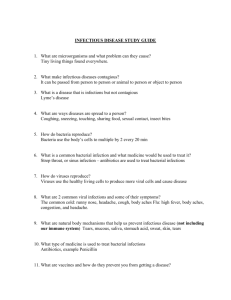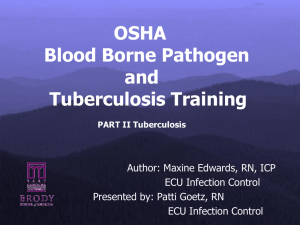Infectious Diseases: Biomedical Technology Presentation
advertisement
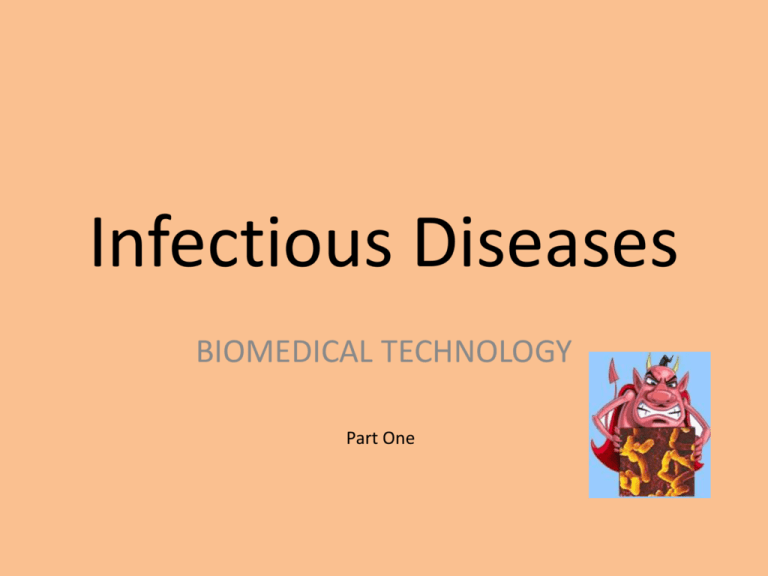
Infectious Diseases BIOMEDICAL TECHNOLOGY Part One OVERVIEW * An Infectious Disease is a disease that is caused by the invasion of a host by agents whose activities harm the host’s tissues. * They cause disease (by impairing normal tissue function) and can be transmitted to other individuals (they are infectious) Vocabulary • Pathogens – Microorganisms that are capable of causing disease. • Infection – Results when a pathogen invades and begin growing within a host. • Disease – results only if and when tissue function is impaired (i.e. burns, skin lesions) Infectious Process • The body has defense mechanisms to prevent infection and to prevent disease after infection occurs. • In order to cause disease, pathogens must be able to enter the host body, adhere to specific host cells, invade and colonize host tissues, and inflict damage on those tissues. Infectious Process Cont. • Entrances to the host: mouth, eyes, genital openings, or wounds. • Growth of pathogens or the production of toxins/enzymes cause disease. • Some normal flora prevent disease. Latent Period • A "latent period" is the lag time between exposure to a disease-causing agent and the onset of the disease the agent causes. • For instance, the latent period between exposure to HIV infection and the onset of AIDS may be many years. • Example: Magic Johnson MICROBES THAT CAUSE INFECTIOUS DISEASES BACTERIA • Small unicellular microorganism that multiplies by cell division. • Found as bacillus (rod shaped), coccus (spherical), or spirillum (spiral) • Anthrax, Cholera, Legionellosis, Lyme Disease, Salmonellas, Strep, TB, Typhoid, Yersinia pestis (plague) • Treatable with antibiotics Bacteria Cont. • Staphylococcus aureus (Staph) – Favorite hangout: skin and nose – Likes: getting inside the body where it can cause a minor infection like a boil, or serious, sometimes fatal infections such as blood infections or pneumonia. – Dislikes: many antibiotics Bacteria Cont. • AEROBES • Reproduces only in the presence of oxygen • ANAEROBES • Reproduce only in the absence of oxygen Facultative anaerobic bacteria: can produce in either environment BACTERIA EXAMPLES: Gram negative – SALMONELLA Gram positive – STAPHYLOCOCCUS Staph infections • Flesh eating early • Impetigo •Flesh Eating bacteria ADVANCED Yersinia Pestis (looks like Pests) • Bacterium that causes Plague • Transmitted via rodents typically VIRUSES Viruses • Apart from the host cell, have no metabolism and cannot reproduce or survive unless they take over a living cell Retroviruses – a classification of viruses • HIV • Certain types of CA • Retroviruses are viruses whose genome consists of RNA not DNA. Think about IT • In February 1997 it was reported that pig cells contain a retrovirus capable of infecting human cells. This is troublesome because of the efforts that are being made to transplant pig tissue into humans (e.g., fetal pig cells into the brains of patients with Parkinson's disease/ hearts etc). Virus Examples • • • • • • • • Chicken pox Cold sores Genital herpes Shingles Small pox AIDS Influenza Rabies-direct contact • West Nile Virus • Ebola → • Hantavirus • Many viruses are preventable via vaccinations • Can be treated with Antiviral drugs • ANTIBIOTICS do not work Smallpox virus More virus examples: • Rhinovirus – The common cold • Influenza • Measles • Mumps↓ Rotaviruses • Gastroenteritis • Wheel shaped virus causing diarrhea • Every year it kills approximately 1 Million children world wide FUNGI Fungi • Have a cell wall and a cell membrane • Includes molds and yeast • Treat with antifungal medication, sometimes with antibiotics. Fungi examples • • • • Ringworm Histoplasmosis Athletes foot Thrush • Yeast or candida are opportunists • Yeast infections are the most common opportunistic infection • Antibiotics reduce normal flora and allow yeast to grow making the pt susceptible to an opportunistic infection PROTOZOA • Acquired through contaminated food or water, or bite of an arthropod (mosquito) • More common in wet climates like the tropics • Amoebic dysentery • Malaria- re-emerging d/t drug resistance and fear of vaccination • Treatable with antibiotics HELMINTHS (WORMS) ewwww! • Simple, invertibrate animals, some infectious parasites • In intestine, blood, body tissue • Medications to force evacuation or death of worms • Swimmer’s itch in US – Schistosoma (flatworm) – Symptoms include abdominal pain and diarrhea • Trichinella spiralis (roundworm) – Ingested in undercooked pork from infected pigs. – Symptoms include vomiting, diarrhea, and abdominal pain SEE NEXT SLIDE FOR PICTURE!!! Filariasis Filariasis- worm infestation in lymphatic system that prevents normal draining of lymphatic fluids. Causes SEVERE swelling. PRIONS (pree-ons) • Extremely small particles that consist only of protein. • Resistant to heat and Disinfectants • No known treatments – Creutzfeldt-Jakob disease – “mad cow disease” in cattle
